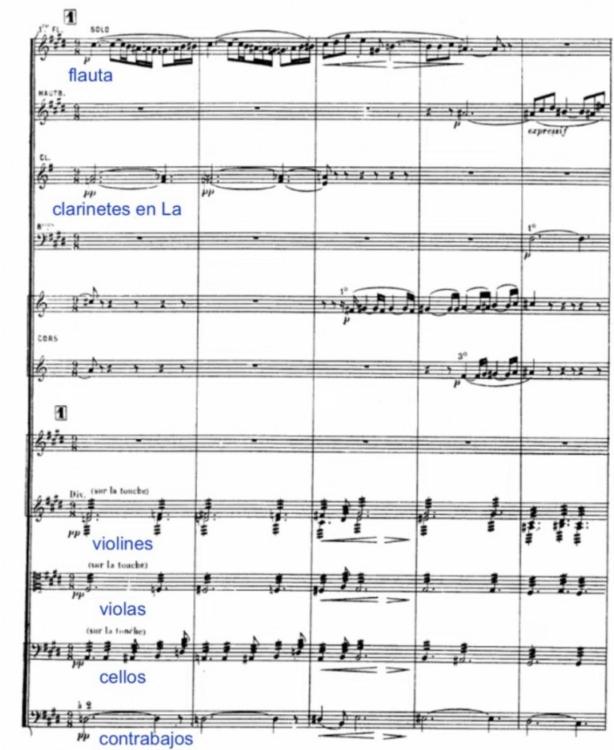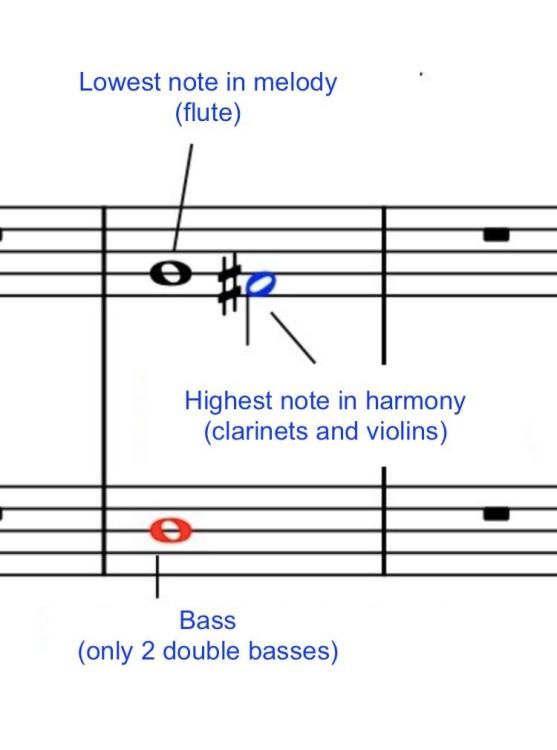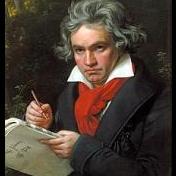Search the Community
Showing results for tags 'Debussy'.
-
DEBUSSY, in the Prelude to the Afternoon of a Faun. Let's just focus on the beginning. To begin with, it is a small orchestration, but rare: there are two oboes + an English horn, two harps... The symphonic poem is based on a melody first exposed by the flute, then re-exposed several times in which it is reharmonized. Debussy's great achievement here, or one of them, is how to make a flute alone, in its low register (which is very weak) and also on piano, to be heard and stand out among the rest of the orchestra... Let's hear it, First we hear the flute alone and at the end of the phrase a transition with the harp and winds. At the rehearsal position marked 1, at approximately 1:03.... is the first harmonization and that is what we are going to refer to. How does Debussy make the flute sound so clear, even though the rest of the orchestra is in pp? There are several things that contribute to this: 1. The dynamics in pp. 2. The tremolando of the strings, which weakens the sound. 3. The tremolando in sul tasto (sur la touche), which makes the sound less bright. 4. Assigning for the bass only two double basses. 5. But the most important thing is the non-interference of the space, of the register. This scheme summarizes everything: the lowest note of the flute is a G natural, and the highest note of the rest of the orchestra is an F# (clarinets and tremolo violins). This way, even though the flute is in a low and weak register, it has all its space to sound on its own. Wonderful.
-
After a two-year hiatus, for the month of December I decided to go back working on this set of 26 minuets which I have been working on off from 2016 to 2017, and stopped in 2018 when I have other things to work on. Here's the status of the minuets as of April 2018: Anyway, after that and up till December, I have gained new musical knowledge and experiences which can be reflected in this new version of the set. More dynamics are added, the pitch range has also been expanded as well and incorporating other forms (Rondo and Sonata) into a few of the minuets as well. Many of the musical ideas for the minuets are taken from several sight-reading books, string quartets by Mozart and Haydn and other composition and theory workbooks. It has been quite a lot of fun finishing the set, exploring new musical ideas and many major/minor keys, and through this I have grown as a composer. I plan to move beyond the piano and work on a set of preludes and fugues for string quartet after this. I also hope to live record these minuets one day, especially the whole tone (XXV). Any suggestions on how to improve, or if you need to understand some of my thinking behind the minuets, you can say so in the comments. (I'm still working on a commentary by the way, but need to tell you that the last uses two different octatonic scales for the minuet and trio respectively.) For those who are not able to listen to the whole set, I suggest looking into these: II (A minor), IV (E minor), VI (E minor), VII (A major), IX (E major), XII (G sharp minor), XIII (F sharp/ G flat major), XIV (E flat minor), XVI (B flat minor), XIX (E flat major), XX (C minor), XXIII (F major), XXIV (D minor), XXV (Homage to Debussy), XXVI (Homage to Prokofiev).
-
I know I accepted that challenge to arrange a Romantic Period symphony that isn't by Beethoven. However, I am finding it quite challenging to both get across the essence of the symphony and not get dangerously close to the original orchestra. In particular, I am finding woodwinds becoming of more importance to that essence. I guess I could resort to a quartet of pianists if I have to, but while I try to figure out both what symphony to arrange and what ensemble to arrange it for, I figured I would do another one of my expansion type arrangements, where I take a piece for a smaller ensemble and arrange it for a larger ensemble. Besides the obvious Classical Period Trifecta, I figured that maybe I could arrange a piece by a later composer. Liszt was definitely out of the question(only piece by Liszt that I think would be suitable for an arrangement is his Liebestraum, and even then, just barely). I knew a lot of composers after Beethoven, both by names and pieces. I further narrowed things down to these composers: Chopin - Melodic grace Grieg - Piano works are well known Tchaikovsky - What looks complicated can turn out very simple(I know this from arranging The Nutcracker Suite for Piano Duet) Mendelssohn - He is like "The Mozart of the Romantic Era" Schumann - Melodic grace Brahms - Similar but clearly different style from Beethoven Debussy - Melody first, harmony second, even the harmony tends to be melodic in nature I then thought "Hmm, maybe I should arrange Reverie" and that sealed the deal. I was going to arrange a piece by Debussy. When people think Debussy, they think Clair De Lune, which I did look at, but decided not to arrange. I looked at other well known Debussy pieces and the one that looked easiest to arrange is Reverie, which also happens to be my favorite Debussy piece. So I decided to arrange that piece. I figured that a trio would fit very well to the piece. I wanted to keep that tender character of the original piece obviously. One instrument that I commonly use to soften a small ensemble like a trio is a flute because the flute, even at forte, still has a tenderness to its timbre. So I figured that the flute should take the main melody(except when that melody goes into the bass clef obviously), the cello should play the bass line, and the violin should harmonize the flute melody. So here is my arrangement of Reverie, what do you think?
-
THE PIANO MUSIC OF CHARLES IVES - *NEW* This New Master Class includes an introduction to Ives and his work; a mini-clinic on the use of dissonance in modern composition/improvisation, and listening and discussions of 5 of Ives' solo piano pieces. http://youtu.be/otGAvFUYDMk You will LUUVV this, free! Blessings and keep swingin, Dave Frank Director, Dave Frank School of Jazz NYC
-
I want to arrange Debussy's piano prelude "Bruyères" for an ensemble of some sort, but I don't know which. The problem is that the original score ranges from a Db1 to an A7, and I'm not quite sure what kind of ensemble has that range. There is of course the string orchestra (if the string basses had a C extension), but that's not quite the color I was looking for. I thought maybe a clarinet ensemble/choir might work, if it had everything from contrabass (BBb, with extension) to sopranino (Eb)...I had also considered a symphonic band, which would clearly have that range given a good tuba player and piccolo player, but I don't have very much experience with writing/arranging for ensembles that large and requiring that many different parts. Are there any other suggestions, or should I just try to go one of the above? (Oh, and here's a YouTube link to the work if you'd like to hear it: )
-
Oh hey everyone, I haven't been on this thing for ages. I am at uni now, studying composition among other things. For one of my assignments we have two different ways we can compose our piece. 1st - Using archetypal shapes or phrases that get repeated with variation, in the style of Syrinx by Debussy. 2nd - Talea and Color in the style of Messiaen. Chord patterns that phase in and out of the pulse of the beat. Here is my idea, i'm going with option 2 btw. I have a 12 tone row which is basically a set of four major and minor triads. The idea is that the base holds the route, once the rest of the triad is played, the bass then moves to the route of the next chord, basically creating three chords per bar rather than two. Here's an example. As you can see in the attached file, it appears as though the chords are: (F+ maj) - (space) - (Cmaj) When in reality because of the held on F+ there are three chords (F+maj) - (F+, E, G) - (Cmaj). The piece continues like this with the route in the bass and the response in the violin and viola being separated. Eventually the viola's rhythm is augmented (x 0.5) and the violin's diminished (x0.5) which creates the middle and the top line phasing in and out with the bass line. Sorry if that's a lot to take in, but is this an example of a talea and color? Is this technically an example of a modern passacaglia? I need to know i'm on the right track. Thanks
-
Right, welcome to the orchestration lessons thread! First lesson on Haydn is attached. Orchestration lessons 1.pdf
- 8 replies
-
- orchestration
- Haydn
-
(and 3 more)
Tagged with:







